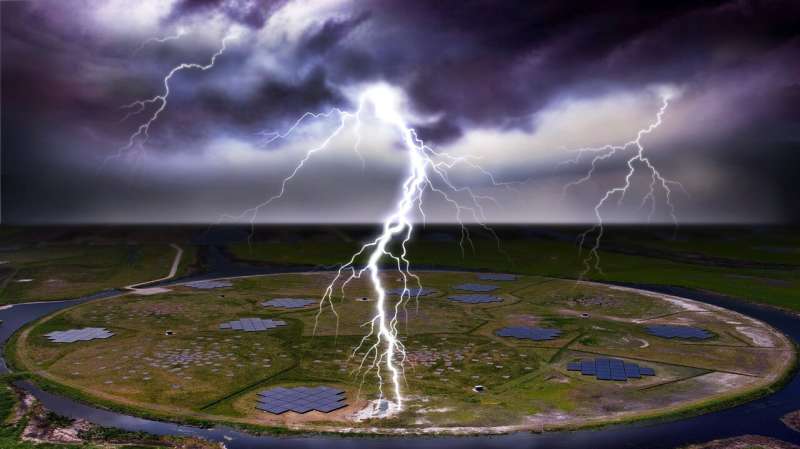Why lightning often strikes twice: Study reveals needle-like structures in positively charged lightning leaders

In contrast to popular belief, lightning often does strike twice, but the reason why a lightning channel is 'reused' has remained a mystery. Now, an international research team led by the University of Groningen has used the LOFAR radio telescope to study the development of lightning flashes in unprecedented detail. The results were published on 18 April in the science journal Nature.
The team used the LOFAR radio telescope to study the development of lightning flashes in unprecedented detail. Their work reveals that the negative charges inside a thundercloud are not discharged all in a single flash, but are in part stored alongside the leader channel at interruptions, at structures that the researchers call needles. This may cause a repeated discharge to the ground.
Needles
"This finding is in sharp contrast to the present picture, in which the charge flows along plasma channels directly from one part of the cloud to another, or to the ground," explains Olaf Scholten, professor of physics at the KVI-CART institute of the University of Groningen. It was never possible to observe the needles before the "supreme capabilities" of LOFAR, adds his colleague Dr. Brian Hare, first author of the paper. "These needles can have a length of 100 meters and a diameter of less than five meters, and are too small and too short-lived for other lightning detections systems."
Low-frequency array (LOFAR) is a Dutch radio telescope consisting of thousands of simple antennas spread over Northern Europe. These antennas are connected with a central computer through fiber-optic cables, which means that they can operate as a single entity. LOFAR is developed primarily for radio astronomy observations, but the frequency range of the antennas also makes it suitable for lightning research, as discharges produce bursts in the VHF (very high frequency) radio band.
For the present lightning observations, the scientists used only the Dutch LOFAR stations, which cover an area of 3,200 square kilometers. This new study analyzed the raw time traces (which are accurate to one nanosecond) as measured in the 30-80 MHz band. Brian Hare says, "These data allow us to detect lightning propagation at a scale where, for the first time, we can distinguish the primary processes. Furthermore, the use of radio waves allows us to look inside the thundercloud, where most of the lightning resides."
Lightning occurs when strong updrafts generate a kind of static electricity in large cumulonimbus clouds. Parts of the cloud become positively charged and others negatively. When this charge separation is large enough, a violent discharge of lightning happens. Such a discharge starts with a plasma, a small area of ionized air hot enough to be electrically conductive. This small area grows into a forked plasma channel that can reach lengths of several kilometers. The positive tips of the plasma channel collect negative charges from the cloud, which pass through the channel to the negative tip, where the charge is discharged. It was already known that a large VHF emission is produced at the growing tips of the negative channels while the positive channels show emissions only along the channel, not at the tip.
A new algorithm
The scientists developed a new algorithm for LOFAR data, allowing them to visualize the VHF radio emissions from two lightning flashes. The antenna array and the very precise time stamp on all the data allowed them to pinpoint the emission sources with unprecedented resolution. "Close to the core area of LOFAR, where the antenna density is highest, the spatial accuracy was about one meter," says Professor Scholten. Furthermore, the data obtained localized 10 times more VHF sources than other three-dimensional imaging systems, with a temporal resolution in the range of nanoseconds. This resulted in a high-resolution 3-D image of the lightning discharge.
The results clearly show the occurrence of a break in the discharge channel at a location where needles are formed. These appear to discharge negative charges from the main channel, which subsequently re-enter the cloud. The reduction of charges in the channel causes the break. However, once the charge in the cloud becomes high enough again, the flow through the channel is restored, leading to a second discharge of lightning. By this mechanism, lightning will strike in the same area repeatedly.
Scholten says, "The VHF emissions along the positive channel are due to rather regularly repeated discharges along previously formed side channels, the needles. These needles appear to drain the charges in a pulsed manner."
"This is a totally new phenomenon," adds Professor Joe Dwyer of the University of New Hampshire (U.S.), third author of the paper: "Our new observation techniques show copious amounts of needles in the lightning flash, which have not been seen before."
Brian Hare concludes: "From these observations, we see that a part of the cloud is re-charged, and we can understand why a lightning discharge to the ground may repeat itself a few times."
More information: Needle-like structures discovered on positively charged lightning branches, Nature (2019). DOI: 10.1038/s41586-019-1086-6 , www.nature.com/articles/s41586-019-1086-6
Journal information: Nature
Provided by University of Groningen

















